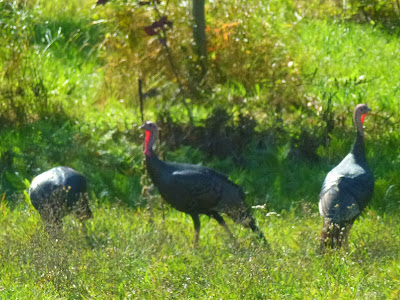
I didn't put out corn, but my grasshoppers were fat and plentiful, and the turkey gang often strolled by. We missed them for a couple of years and wondered if there had been a turkey plague. Then someone told us that a lady who lived a mile or so away was feeding them and they had all gone there. We had forgotten about that until one afternoon we drove past at about four in the afternoon and saw them lined up against a fence, all looking at her house, waiting. There must have been between 40 and 50 of them. In a couple of intervening years, things have simmered down. Perhaps the grain had become too great an expense? But now they are back. This summer I saw a mother with five poults over a period of about a month. I'm pretty sure that the ancestors of these guys were reintroduced after being extirpated over most of their range in the Nineteenth Century.
[Alas, just posted by mistake, unfinished and with plenty of typographical errors. Now all fixed, I hope.]
There's a hummingbird poem in The New Yorker! November 25, 2013, page 84.
I thought she was exaggerating a little
when she said that every one of her hummingbirds--she had five--
has a distinct name and that they flew
freely in her garden, where they had
distinct feeders. "If not, they fight too much."
But it was like that, just like that:
I saw them once, when the house, alone,
invited a visit to the open back garden.
There they came flying like tiny
winged envoys
with urgent notices and warnings.
No name fit them well. Useless
words. Astonishment
at the rapid movement of the wings:
the not being able to look at them
the approach of their tiny hearts
beating so incredibly rapidly
close, very close,
and then suddenly shooting off, high,
unattainable.
Beings of our world but also of another,
only theirs.
*** Circe Maia
(Translated from the Spanish by Jesse Lee Kercheval.)
[Alas, just posted by mistake, unfinished and with plenty of typographical errors. Now all fixed, I hope.]
There's a hummingbird poem in The New Yorker! November 25, 2013, page 84.
HUMMINGBIRDS
I thought she was exaggerating a little
when she said that every one of her hummingbirds--she had five--
has a distinct name and that they flew
freely in her garden, where they had
distinct feeders. "If not, they fight too much."
But it was like that, just like that:
I saw them once, when the house, alone,
invited a visit to the open back garden.
There they came flying like tiny
winged envoys
with urgent notices and warnings.
No name fit them well. Useless
words. Astonishment
at the rapid movement of the wings:
the not being able to look at them
the approach of their tiny hearts
beating so incredibly rapidly
close, very close,
and then suddenly shooting off, high,
unattainable.
Beings of our world but also of another,
only theirs.
*** Circe Maia
(Translated from the Spanish by Jesse Lee Kercheval.)



























